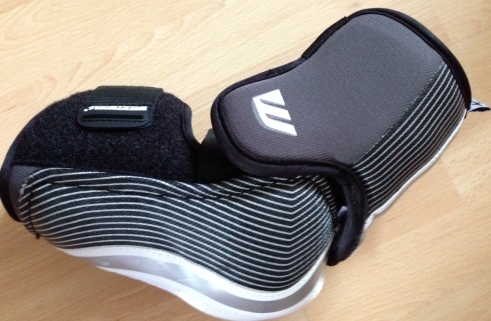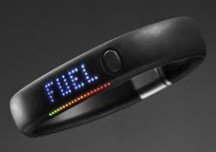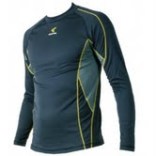The brand:
The Winnwell brand is a bit of a new one to us, having not really seen much of the equipment in the European hockey stores or featured much in trade shows. In the NHL, Winnwell is perhaps more known for its gloves than other visible equipment. It does manufacture shoulder pads, sticks and shin pads.
Having done a bit of research into the company, they have been around the game since forever it seems. Winnwell has a strong pedigree in manufacturing protective equipment that has been built with the pros in mind and to pro-spec. Further research shows that some of the games’ greats have worn Winnwell equipment so the brand certainly has the pedigree behind it. However, Winnwell might not have the marketing budget of some of the other big brands, but does that hinder the quality of equipment? That’s what we are going to find out.
The equipment features:

Side profile of the Winnwell Pro-Stock Elbow Pads
What we have been testing is the Winnwell Pro Stock elbow pads. The elbow pads, the company says, have been built to the specifications and demands of the professional player. When you look at the gear out of the box (or bag in this instance), the elbow pads definitely have an ‘old-school’ feel to them and a look and profile that is akin to the days of the good old Jofa protective. In fact if you Google Jofa 9144 Pro Stock Elbow pads, you’ll see a striking resemblance between the two.
Where most elbow pads have gone towards a more low profile look, Winnwell has provided a protective that calls back to the good old days of hockey. The shoulder cups are actually quite deep in comparison to many other elbow pads in the market. This design ensures good strong fit for the pads. However, it can be a bit of a shock depending on what you are used to wearing. If you have been wearing some of the lower profile elbow pads, the first time you wear the Winnwell product you’ll feel a bit out of sorts to begin with, but even towards the end of our first session with these pads they felt really comfortable towards the end.
The elbow pads come with Winnwell’s clean hockey technology which is designed to keep its equipment smelling fresh. After 2 months of use on the pads, there is hardly any “hockey” scent on the elbow pads.
Breaking in and fit:
Breaking the elbow pads in was a bit of a strange experience. Out of the bag the elbow pads do feel a bit stiff, which is to be expected with any new piece of equipment. On first use the pads felt extremely comfortable, but for the first 20-30 minutes of training the elbow pads felt a bit stiff which did affect shooting and puck handling a little bit. This trend lasts probably about 3-4 training sessions before you are fully accustomed to the elbow pad. But like said above, towards the end of each of the first few sessions the pads actually feel really comfortable and you hardly notice you are wearing new pads.

Sticky material on the wrist guard helps keep the pad in place
As mentioned the elbow cups are a bit deeper than other elbow pads, which can take a bit longer to get used to. However, what the deeper cup has resulted in is comfort and great fit. The elbow pads come with a sticky liner on the wrist that has been designed to keep the pad in place against the compression layer. Having used both T-shirt and compression long sleeve, the elbow pads do stay in place, which is a rare feat in elbow pads. Often during a game you have to fix and alter the position of your elbow pads, but the Winnwell Pro-Stock does actually stay in place relatively well.
However, the only criticism that there is to the Winnwell Pro-Stock elbow pads is that the Velcro attachment areas could be a bit bigger to ensure a tighter fit. Despite wearing the right size, there is still a little bit of slack on the bicep area of the elbow pad.
Value for money
What the Winnwell Pro-Stock elbow pad scores big on is value for money. The elbow pad provides protection that is equal to the top of the range CCM, Reebok, Bauer or Warrior gear, but at a fraction of the cost. The graphical design isn’t something that will set the world on fire, but then again the elbow pads are under your jersey, so it doesn’t matter what they look like. The main point is that they protect your elbows and bicep.
For £45 for elbow pads you cannot go wrong. Do not let the relatively low price tag of Winnwell’s equipment fool you. It does not mean that the product is bad quality or that there’s something wrong with it, far from it. We think that this piece of equipment is where price and quality meet. You are not paying over the odds for a top of the range elbow pad and it will not leave you hanging dry. The elbow pads do not rely on any gimmicks and we have been positively surprised by them.
Durability:
 As mentioned above, the Winnwell Pro-Stock elbow pad will not break the bank, but one thing that people will question is that whether a sub £50 elbow pad will actually last or if it is going to fall to pieces after a few months use. We have had these elbow pads for almost five months in active use, but during the time there have been no faults with the equipment. The straps are still where they’re supposed to be, the elastic straps have not lost any elasticity (though this will happen over time on any piece of protective).
As mentioned above, the Winnwell Pro-Stock elbow pad will not break the bank, but one thing that people will question is that whether a sub £50 elbow pad will actually last or if it is going to fall to pieces after a few months use. We have had these elbow pads for almost five months in active use, but during the time there have been no faults with the equipment. The straps are still where they’re supposed to be, the elastic straps have not lost any elasticity (though this will happen over time on any piece of protective).
Despite taking a few falls and purposefully elbowing plexi glass at the rink, there are no signs that the cover of the protective cup has worn.
Conclusion:
Once the elbow pads have been fully broken in, they perform really well and equally to other top of the range elbow pads. The Winnwell Pro-Stock elbow pads hark back to the era of the good Jofa equipment. The pads are relatively lightweight compared to others. In comparison, the Winnwell Pro-Stock weighs about the same as CCM U12 elbow pads, so that’s not too bad.
We’d recommend the elbow pads for both league players, as well as recreational players who are looking for good quality protection but don’t want to spend too much money. That’s not to say that this is a beer league level pad, far from it. It can cope with the demands of the professionals, but for those that want top of the range protection, why pay over the odds.
Pros:
- Great value for money
- Durable
- Stays in place during play
- Comfortable
- Great ‘old school’ feel
Cons:
- Can take a while longer to break in than others
- Can feel a bit bulky at first few uses
- The Velcro strap areas could be a bit longer for tighter fit in places


















